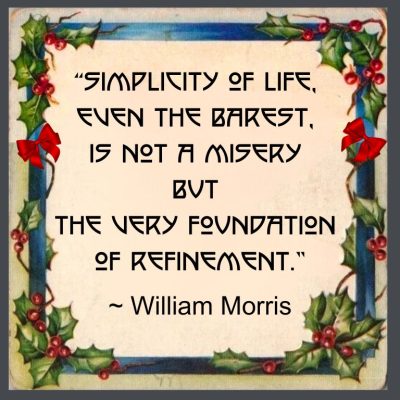 Wondering how to decorate your bungalow for the holidays? Let this quote by William Morris, the father of the Arts & Crafts Movement be thy guide.
Wondering how to decorate your bungalow for the holidays? Let this quote by William Morris, the father of the Arts & Crafts Movement be thy guide.
I grew up with a mother dedicated to creating magical moments for her family, & zhuzhing up the place for the holidays every year was high on the list. (Though her credo was,”Less is more,” I’m not going to swear that she was true to it.) In consequence, as the days at the Hare House, my 1910 Craftsman began getting shorter, & the weather started cooling, I was prompted to consider the holiday decorations that the Reverend & Grace Hare might have chosen back in 1910. Though childless, they had family nearby & were of sufficient standing in the community that it would have been expected that they would entertain. The Hares were reasonably affluent, with refined tastes, but they were not lavish spenders. The lot they chose was not on the prestigious Eagle Rock street of Hill Drive. The house had only two bedrooms & a single bath. In the bathroom they chose to use scored plaster instead of tile. The fireplace sported a modest hearth, covered in smooth tile rather than the more ornate Batchelder that was often seen in our neighborhood. I could not imagine that the Hares would change their habits for the holidays. My thought was to follow Morris’ inspiration & choose the simplicity of natural materials from Grace’s garden decorate my bungalow.
PLANNING MY HOLIDAY GARDEN
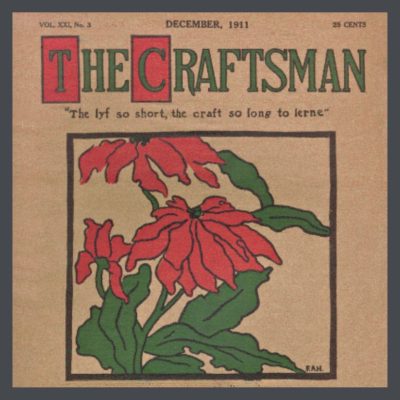 “The houses were decked with evergreens in December
“The houses were decked with evergreens in December
that the sylvan spirits might repair to them and remain unnipped
with frost & cold winds until a milder season had renewed the
foliage of their darling abodes.”
~Quoting the Druids in CHRISTMAS DECORATIONS FROM WINTER’S GARDEN, The Craftsman Magazine, 1911.
(Read the complete article here. It is lovely!)
My first bungalow holiday in The Hare House, was a year in the making. I moved in in December of 1998 & started thinking about the next Christmas. I had been living in a terrific Mid-Century hillside house in Pasadena. Because the Hare House was built before electricity came to that part of what would be Los Angeles, I didn’t feel like I would do the same celebration with the 50’s colored lights & Blow Mold Santas.
As I planted my garden beds at the Hare House, I thought of Stickley, & wanting to remain “unipped” in the cold winds of Los Angeles, I considered what might be good choices for Christmas foliage for my darling abode. Asparagus ferns are a total takeover nightmare, but I decided to plant a couple to use on the deep mantel & above the built-ins in the dining room. They bounce back even after the closest haircut & provide a nice fluffy element. I am in love with ferns, so I planted a few different types, again thinking of bedecking the halls.
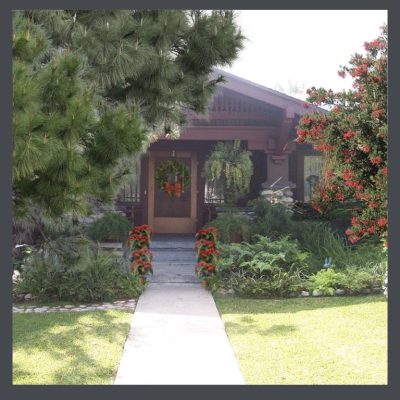 CHRISTMAS DECORATIONS FROM WINTER’S GARDEN also suggested, “Of those bearing bright berries that we can gather from the woods or fields to adorn our homes at this Christmas season, perhaps the general favorite in the East is the holly—in the West it is the toyon. These two glossy leaved bushes of the scarlet berries are too well known to need words in their favor.”
CHRISTMAS DECORATIONS FROM WINTER’S GARDEN also suggested, “Of those bearing bright berries that we can gather from the woods or fields to adorn our homes at this Christmas season, perhaps the general favorite in the East is the holly—in the West it is the toyon. These two glossy leaved bushes of the scarlet berries are too well known to need words in their favor.”
I was lucky enough to have toyons on my property, perennial California native shrubs that had been trimmed into trees. Also known as Christmas berry, I knew that they would provide me with all the red berries that I would need. Fortunately, the tree in back produced a sufficient quantity that I could leave all the lovely, red berries on the tree to decorate my front yard.
When I left L.A. for Florida, I requested that my sister-in-law in California gather toyon berries & bring them to me in her suitcase. I adorned the mantel & sideboard of my 1925 bungalow with the little red berries from California, adding large, shiny magnolia, the tree of the South, leaves to the mix.
I crafted a fluffy wreath out of pine cuttings, added pinecones & a bow & hung it on my door to greet my guests as they entered, after walking up the poinsettia lined steps.
LET THERE BE LIGHT
Though Edison offered strings of decorative electric lights as far back as 1890, power would not come to Eagle Rock until 1914 so I used candles to re-create the simple, but festive holiday home of these people for whom I held such affinity & admiration.
I clipped branches of our huge, old pine which I augmented with branches of other conifers & fluffed up with the ferns I had planted the year before. These I piled the on mantel & the top of my sideboard, & strew across my dining table, then tucked in candleholders of various sizes. I added pinecones & the prickly little pods I’d gathered from the neighborhood. The pods I had sprayed gold & I handled them with care because they were full of nasty little stickers. For color I used batches of toyon berries & pomegranates from my local Trader Joe’s. I had considered apples, but discarded the idea in favor of the richer color of the exotic pomegranate.
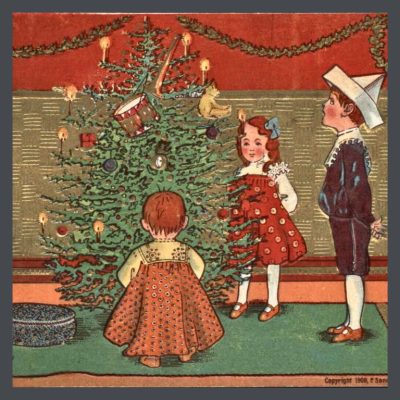 My tree was fir. Since childhood my mother had taught me about Christmas trees adorned by candles. Because they came into common use in 1917, & the town where she lived had been electrified in 1911, I’m thinking that she, born in 1919, never got to have the experience of candles balanced on the ends of branches. My mother’s tales of these candles included stories of horrible fires so I didn’t go that route, instead opting for strings of white electric lights which seemed like a good (but sorry) compromise, though quite likely the Hare’s used candles on their tree. I had some of my mother’s childhood glass & celluloid ornaments which I embellished with the ones that I had gifted her over the years.
My tree was fir. Since childhood my mother had taught me about Christmas trees adorned by candles. Because they came into common use in 1917, & the town where she lived had been electrified in 1911, I’m thinking that she, born in 1919, never got to have the experience of candles balanced on the ends of branches. My mother’s tales of these candles included stories of horrible fires so I didn’t go that route, instead opting for strings of white electric lights which seemed like a good (but sorry) compromise, though quite likely the Hare’s used candles on their tree. I had some of my mother’s childhood glass & celluloid ornaments which I embellished with the ones that I had gifted her over the years.
My mother loved tinsel & insisted that each piece be carefully draped a single piece at a time, over individual branches. Tinsel originated in Germany as strands of thin, beaten silver to reflect the light from the candles. Being affordable to only the wealthy, the next generation of tinsel was made of an alloy of tin & lead. I’m thinking that due to the avarice of the lead industry, which was allowed to continue for decades, both our families suffered the misfortune of handling this material.
The gift wrapping at the time was very simple, usually red or green or white tissue paper, or even plain brown paper. Modern gift wrap was invented by the Hall brothers, of Hallmark fame, in 1917 & it seemed a bit out of place in our simple holiday. I did use cellophane tape though, which was not invented until 1930. String & sealing wax were used prior & I’m an admitted Luddite but with the craziness of the holidays, I didn’t feel like sitting around manipulating hot wax around the noses of overly curious kitties.
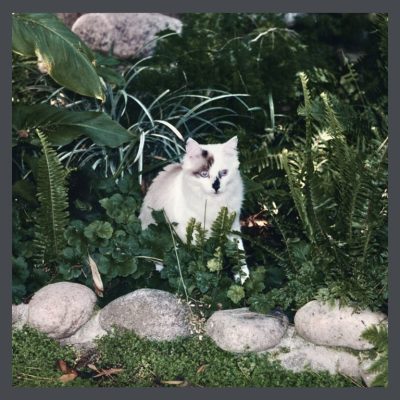 ”Would we not be entering more into the spirit of Christmas by going out to meet it, as it were, by searching for these aromatic symbols of immortality & bringing them into our homes, rather than by unromantically ordering wreaths, vines & branches from the florist’s.”
”Would we not be entering more into the spirit of Christmas by going out to meet it, as it were, by searching for these aromatic symbols of immortality & bringing them into our homes, rather than by unromantically ordering wreaths, vines & branches from the florist’s.”
My decor was very simple but elegantly brought the aromatic, natural world indoors & clearly conveyed the spirit of the holiday. As I picked up my shears & my grandmother’s woven basket, & headed out to the garden with my pussy-cat, I thought of Grace Hare & my grandmother preparing for their holidays & felt the peace of the season.
ENJOY THE HOLIDAYS AT STICKLEY’S CRAFTSMAN FARMS
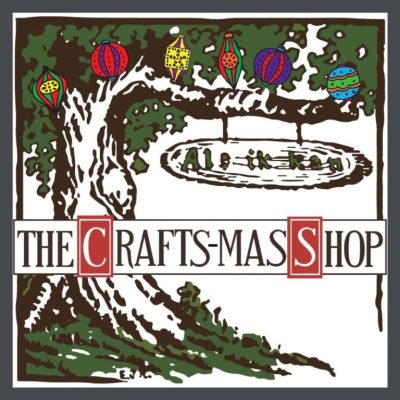 The Stickley Museum at Craftsman Farms is a National Historic Landmark & historic house museum, located on the campus of Craftsman Farms in Parsippany, New Jersey. It was built by Gustav Stickley between 1908 & 1917 as the most complete expression of his “Craftsman” style & provides an unmatched opportunity to experience Stickley’s ideas about the impact of architecture, design, & landscape on a meaningful life. The Log House, which was the Stickley family home, will be decorated in period holiday décor & will be open for holiday tours. Their Crafts-Mas Open Houses are: Saturday, Dec 2nd Saturday, Dec 9th Saturday, Dec 16th Their holiday tours of the log house are: Dec 3rd: Tours at 12pm and 3pm Dec 10th: Tours at 12pm and 3pm Dec 17th: Tours at 12pm and 3pm
The Stickley Museum at Craftsman Farms is a National Historic Landmark & historic house museum, located on the campus of Craftsman Farms in Parsippany, New Jersey. It was built by Gustav Stickley between 1908 & 1917 as the most complete expression of his “Craftsman” style & provides an unmatched opportunity to experience Stickley’s ideas about the impact of architecture, design, & landscape on a meaningful life. The Log House, which was the Stickley family home, will be decorated in period holiday décor & will be open for holiday tours. Their Crafts-Mas Open Houses are: Saturday, Dec 2nd Saturday, Dec 9th Saturday, Dec 16th Their holiday tours of the log house are: Dec 3rd: Tours at 12pm and 3pm Dec 10th: Tours at 12pm and 3pm Dec 17th: Tours at 12pm and 3pm
See you there!
STAY IN THE BUNGALOW KNOW!!!
Sign up for our newsletter & receive our FREE E-book, 7 VITAL Things to Do Before You Hire a Contractor.




0 Comments